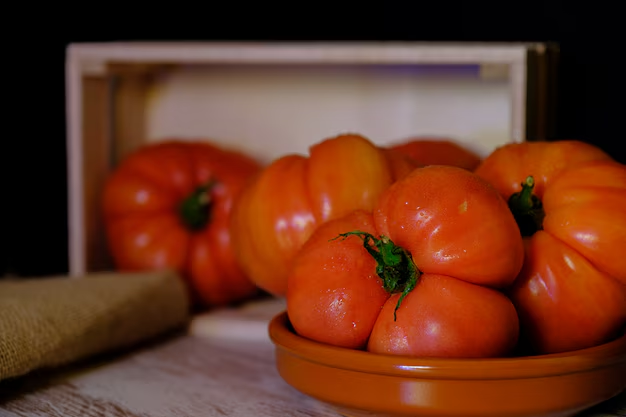Should You Keep Tomatoes in the Refrigerator? Here's What You Need to Know
Few culinary questions spark more debate than whether to refrigerate tomatoes or not. This seemingly simple decision divides home cooks, chefs, and even food scientists. In this comprehensive guide, we’ll peel back the layers of this tomato storage dilemma and offer practical insights. Whether you're a passionate gardener, a casual cook, or a curious consumer, understanding how best to store tomatoes will help you maintain their taste and texture. 🍅
Understanding Tomato Composition and Ripeness
Tomatoes are a fruit, botanically speaking, that undergo complex changes in texture and flavor as they ripen. Understanding a bit about their composition will clarify why storage considerations matter.
What Happens When Tomatoes Ripen?
Tomatoes develop their flavor and color through a process known as ripening, guided by natural chemicals and enzymes:
- Chlorophyll Breakdown: As tomatoes ripen, chlorophyll degrades, turning them from green to red.
- Flavor Compound Development: Ripening also enhances the production of flavor compounds, which contribute to their characteristic taste and aroma.
- Texture Changes: The flesh becomes softer and juicier, making them delicious but somewhat delicate.
Ripeness and Storage Needs
The stage of ripeness significantly influences how you should store tomatoes:
- Unripe (Green): Firmer in texture and less flavorful, these are best left on the counter to ripen naturally.
- Partially Ripe (Blush): When their color just starts changing, they can continue ripening at room temperature or, for slower ripening, in the refrigerator.
- Fully Ripe: Brightly colored and aromatic, these tomatoes are at their peak flavor and benefit most from immediate consumption or short-term storage based on temperature.
The Refrigerator Debate: Should You Chill Your Tomatoes?
The central question remains: is it okay to put tomatoes in the refrigerator? Opinions vary widely, but general guidance emphasizes balance and timing in storage decisions.
The Case Against Refrigeration
Refrigeration can indeed impact the texture and taste of tomatoes:
- Flavor Loss: Cold temperatures can dull the flavor-producing enzymes, leading to less aromatic tomatoes.
- Texture Changes: Tomatoes stored in the refrigerator might suffer from an altered, mealy texture due to the breakdown of cell walls.
When Refrigeration Makes Sense
Not all scenarios call for avoiding the fridge. There are times when refrigerating tomatoes is pragmatic:
- Preventing Over-Ripening: If a tomato is fully ripe and consumption is not immediate, refrigeration can slow down further ripening and spoilage.
- Food Safety Concerns: In high temperatures, refrigeration might be necessary to ensure tomatoes do not spoil quickly, thus preventing foodborne illnesses.
Best Practices for Tomato Storage
Knowing the pros and cons of refrigeration, here’s how you can keep your tomatoes fresher, longer.
At Room Temperature
- Ideal for Unripe to Almost Ripe Tomatoes: Place them stem side down in a single layer, away from direct sunlight.
- Check Daily: Monitor for ripeness and use or move to the fridge as needed.
In the Refrigerator
- Short-Term Option for Fully Ripe Tomatoes: If you can't consume them right away, refrigerate for no more than a few days to mitigate flavor loss.
- Use a Paper Towel Layer: Place tomatoes on a paper towel to absorb moisture and reduce the risk of rot.
A Balanced Approach
- Bring to Room Temperature Before Eating: If refrigerated, tomatoes regain some of their lost flavor and texture after a few hours back on the counter.
- Consider Other Factors: Variety, environmental conditions, and personal preference all play a role.
Related Subtopics: Enhancing Your Tomato Knowledge
While storage is critical, other factors enrich the tomato consumption experience.
Tomato Varieties and Their Storage Peculiarities
Not all tomatoes are created equal. Here's a quick overview of how different types might influence storage:
- Heirlooms: Known for their rich flavors, they are often more delicate and sensitive to refrigeration.
- Cherry and Grape Tomatoes: These smaller varieties tend to hold their texture better in the fridge but are best consumed quickly.
- Plum Tomatoes: Often used for sauces, may tolerate cooler storage conditions without significant quality loss.
Cooking Tips to Maximize Flavor
Implementing these tips can enhance your dish even if your tomatoes have been refrigerated:
- Roasting to Intensify Flavors: Roasting softens the texture further, concentrating sugars for a sweeter taste.
- Pairing with Acids: Adding a splash of lemon juice or balsamic vinegar can elevate flavor when fresh taste is compromised.
- Blending into Sauces: Puréed, any texture changes become unnoticeable, and you can focus on adjusting seasoning.
Preservation Alternatives
Looking beyond the refrigerator, explore options that extend tomato season:
- Canning: A safe method to store tomatoes for up to a year.
- Freezing: While changes the texture significantly, it's perfect for soups and stews.
- Drying: Sun-drying or using a dehydrator intensifies flavors, offering a long shelf life.
Quick Reference Summary 📝
Here's a handy checklist to ensure you're storing tomatoes optimally:
- ✅ Room Temperature: Best for unripe to nearly ripe tomatoes.
- ✅ Refrigerate If: They're fully ripe but not ready to eat immediately.
- ✅ Bring to Room Temp: Post-refrigeration, let them rest outside the fridge to regain some flavor.
- ✅ Consider Cooking Methods: For refrigerated tomatoes, roasting or saucing can revive qualities.
- ✅ Explore Varietal Needs: Different tomatoes have varying susceptibilities to cold storage.
Understanding whether to refrigerate tomatoes requires consideration of ripeness, variety, and ultimate use. By following these guidelines and insights, you can savor the best that tomatoes have to offer, regardless of the season. Whether you're enjoying them fresh in a salad or cooked into a comforting sauce, the key lies in thoughtful storage to enhance their natural goodness. 🍅✨
